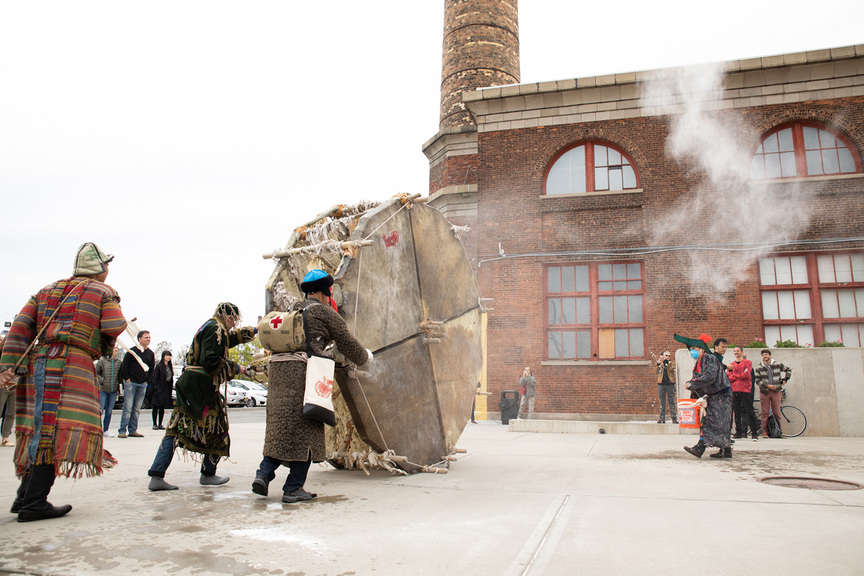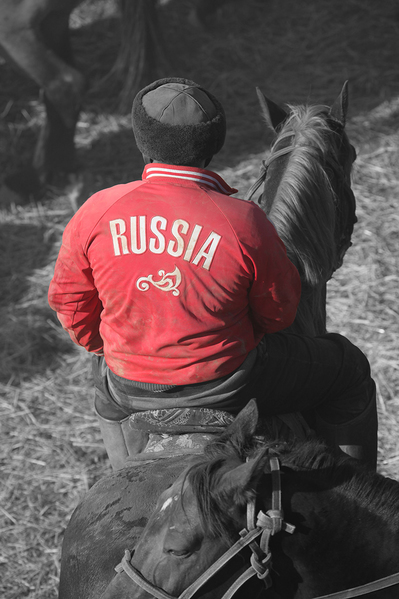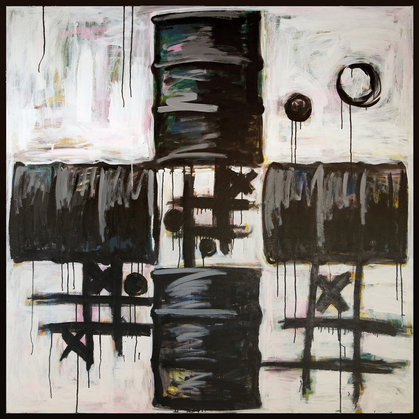-
From Current Issue
-
- Editor’s Letter Fire in the Heart
- Reviews I Gusti Ayu Kadek Murniasih
- Reviews 11th Seoul Mediacity Biennale: “One Escape at a Time”
- Dispatch Networked China
- One on One Monira Al Qadiri on Yukio Mishima
- Essays The rise of independent art spaces in pandemic-era Shanghai
- Features Tuan Andrew Nguyen
- Table of Contents
- Web Exclusives
- Archive
- Subscribe

R
E
V N
E
X
T
Installation view of KYZYL TRACTOR ART COLLECTIVE’s “Thinking Collections: Telling Tales” at Mana Contemporary, Jersey City, 2018, presented as part of the Focus Kazakhstan project. Photo by Michael Wilson. Courtesy Asia Contemporary Art Week, New York, and the National Museum of Kazakhstan, Astana.
Four men, members of the Kyzyl Tractor Art Collective, rolled a large drum made of wool, wood, ropes, metal, sheepskin and plastic onto the front lawn of Mana Contemporary in Jersey City. Turned on its side like a wheel, the Purification Drum (2003/2018) easily towered over them as they steered it through the crowd of onlookers. Using a whip-like stick, one man beat the taut surface as he pushed and rotated the drum onto the pavement. Another trailed behind him, dragging what appeared to be a stack of rectangular rugs. Water rained over the concrete as a man carrying a bucket tossed its contents into the air. As the troupe pivoted around the corner, smoke and ash filled the air. People continued to follow the ceremonial procession as it entered the building, concluding inside the galleries.
Debuting in the United States, Purification is a cleansing ritual that celebrates Shamanistic customs while also self-consciously presenting them in a post-modern context. The performance took place as part of “Thinking Collections: Telling Tales,” a survey exhibition of the Kyzyl Tractor Art Collective presented by Asia Contemporary Art Week 2018 in collaboration with the National Museum of the Republic of Kazakhstan and the Focus Kazakhstan project. Perhaps sensing what a rare opportunity this was to present one of Central Asia’s most prominent artist collectives to a new audience, curator Leeza Ahmady and co-curator Vladislav Sludskiy packed the show with an almost overwhelming number of works, from paintings to sculptural installations and videos. Documentation of the collective’s past performances, including previous iterations of Purification in cities like Prague, comprised a large part of the exhibition.
The five featured artists—Said Atabekov, Smail Bayaliyev, Moldakul Narymbetov, Arystanbek Shalbayev and Vitaliy Simakov—represent the core of Kyzyl Tractor. First formed in the early 1990s, the collective incorporates traditional Kazakh folklore and indigenous materials into their artistic practice. At the same time, their work observes and re-examines nomadic culture in the context of capitalism and industrialization. For instance, a tractor “logo”—seen stamped on goods such as bottles, plates and textiles—serves as a recurring symbol about national identity borrowed from Soviet rule.
Meanwhile, the horse and horseback riding, emblematic of traditional nomadic life, frequently reappear with an ironic twist. Atabekov’s photo series “Steppen Wolfs” (2009–17) captures riders participating in the Kazakh national game kokpar wearing brand name clothing. While the men and their horses are depicted in black and white, sweatshirts bearing the logos for Twitter and Coca-Cola are in color. The soft drink logo also reappears spray-painted on a ceramic saddle in the product’s signature shade of red in Coca-Cola Saddle (2016) by Atabekov. The piece was displayed alongside other readymade saddles, which the artist bejeweled with the logos of designer labels like Chanel, DKNY and Dolce & Gabbana, highlighting Kazakhstan’s delayed participation in the global, capitalist market following the end of the Cold War.
Prolific painters, Shalbayev and the late Narymbetov grappled with the impact of the oil industry on the nation. Shalbayev paints black oil drums surrounded by tic-tac-toe squares in The Game (2016), from the series “Matches-Barrels” (2016) to comment on the economic and political exploitation of the country’s profitable resource. In Untitled (Oil Derrick) (circa 2000s) from the “My Kazakhstan” series, Narymbetov made his point by illustrating the drilling process in gold acrylic paint.
One of the only pieces to be commissioned for “Thinking Collections: Telling Tales,” Chest of Knowledge (2018) stood as a monument to the group’s 30-year history. The austere wool casing opened to reveal a variety of archival materials, including personal photographs, books, percussive instruments and plastic horse figurines. Natural objects such as feathers, rocks and sticks rounded out the contents. Not unlike the exhibition itself, no singular narrative appeared to emerge from the eclectic collection of items. Overall, however, the collective’s collaborative and prolific efforts did offer a clear-eyed and distinct vision of a society undergoing rapid change, whose fate is yet to be determined.
Mimi Wong is a New York desk editor of ArtAsiaPacific.
“Thinking Collections: Telling Tales” is on view at Mana Contemporary, Jersey City, until November 30, 2018.
To read more of ArtAsiaPacific’s articles, visit our Digital Library.














